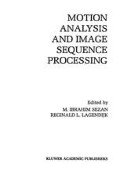Abstract
Visual signals, even more than audio signals, typically contain an exorbitant amount of information. It is not uncommon for the visual component of a motion picture or television signal to contain several orders of magnitude more data than the audio component. During this age of visual information transmission and storage, efficient methods for compressing video have become particularly important.
Access this chapter
Tax calculation will be finalised at checkout
Purchases are for personal use only
Preview
Unable to display preview. Download preview PDF.
References
R. Gray, “Vector quantization,” ASSP Magazine, pp. 4–29, April 1984.
A. Gersho and R. Gray, “Vector quantization and signal compression,” Kluwer Academic Publishers, 1992.
W. H. Equitz, “New vector quantization clustering algorithm,” IEEE Trans. Acoustics, Speech, Signal Processing, vol. ASSP-37, pp. 1568–1575, October 1989.
K. K. Truong and R. M. Mersereau, “Structural image codebooks and the self-organizing feature map algorithm,” Proc. 1990 IEEE Int. Conf. Acoustics, Speech, Signal Processing, pp. 2789–2792.
N. Nasrabadi and R. Feng, “Vector quantization of images based upon Koho-nen self-organizing feature map,” Proc. 1988 IEEE Int. Conf. Neural Networks, pp. 101–108.
K. K. Truong, “Multilayer Kohonen image codebooks with a logarithmic search complexity,” Proc. 1991 IEEE Int. Conf. Acoustics, Speech, and Signal Processing, pp. 2789–2792.
B. H. Juang and A. H. Gray, “Multiple stage vector quantization for speech coding,” Proc. 1982 IEEE Int. Conf. Acoustics, Speech, Signal Processing, pp. 597–600.
J. Foster, R. M. Gray and M. O. Dunham, “Finite-State Vector Quantization for Waveform Coding,” IEEE Trans. Info. Th., vol. IT-31, pp. 348–359, May 1985.
R. Aravind and A. Gersho, “Low-rate image coding with finite-state vector quantization,” Proc. 1986 IEEE Int. Conf. Acoust, Speech, Signal Processing, pp. 137–140.
J. Makhoul, S. Roucos, and H. Gish, “Vector quantization in speech coding,” Proc. IEEE, vol. 73, pp. 1551–1581, November 1985.
F. Kossentini, M. Smith, and C. Barnes, “Image coding with variable rate RVQ,” Proc. 1992 IEEE Int. Conf. Acoustics, Speech Signal Proc, pp. 369–372.
C. F. Barnes, Residual Quantizers, PhD thesis, Brigham Young University, Provo, Utah, Dec. 1989.
F. Kossentini, M. Smith, and C. Barnes, “Large block RVQ with multipath searching,” Proc. 1992 IEEE Int. Symp. Circ. Syst., pp. 300–303.
F. Kossentini, M. Smith, and C. Barnes, “Finite-state residual vector quantization” submitted to J. Vis. Commun. Im. Rep., 1992.
K. K. Truong and R. M. Mersereau, “Variable rate vector quantization for images based on principles of cache memory design,”submitted to IEEE Trans. Image Processing, 1992.
M. Liou, “Overview of the px64 kbit/s video coding standard,” Comm. ACM, vol. 34, pp. 59–63, April 1991.
D. A. Huffman, “A method for the construction of minimum redundancy codes,” Proc. IEEE, vol. 40, pp. 1098–1101, 1952.
E. G. Coffman and P. J. Denning, Operating Systems Theory, Prentice-Hall, 1973.
H. S. Stone, High-Performance Computer Architecture, Addison-Wesley, 1987.
J. W. Woods and S. D. O’Neil, “Subband coding of images,” IEEE Trans. Acoustics, Speech, Signal Processing, vol. ASSP-34, pp. 1278–1288, October 1986.
C. S. Kim, J. Bruder, M. J. T. Smith, and R. M. Mersereau, “Subband coding of color images using finite state vector quantization,” Proc. 1988 IEEE Int. Conf. Acoustics, Speech, Signal Processing, pp. 753–756.
P. H. Westerink, Subband Coding of Images, Ph.D. Thesis, Technische Universiteit Delft, 1989.
M. Smith and S. Eddins, “Analysis/synthesis systems for subband image coding,” Trans. Acoustics, Speech, Signal Processing, vol. ASSP-38, pp. 1446–1457, August 1990.
R. de Quieroz, “Subband processing of finite length signals without border distortion,” Proc. 1992 Int. Conf. Acoustics, Speech, Signal Processing, vol. 4, pp. 613–616.
S. A. Martucci, “Signal extension and noncausal filtering for subband coding of images,” SPIE Conf. Vis. Commun. Image Proc. ′91: Visual Communication, vol. 1605, pp. 137–148.
R. Ansari, “Advanced television coding using exact reconstruction filter banks,” in Subband Image Coding, (J. Woods, editor), Kluwer Academic Publishers, 1991.
C. S. Kim, M. J. T. Smith, and R. M. Mersereau, “Two-stage multirate coding of color images,” Signal Processing: Image Communications, vol. 3, pp. 79–89, February 1991.
T. Koga et al., “Motion compensation interframe coding for video conferencing,” Proc. Nat. Telecommun. Conf., pp. G5.3.1–5, 1981.
N. S. Jayant and P. Noll, Digital Coding of Waveforms, Englewood Cliffs, NJ: Prentice-Hall, Inc., 1984.
CCITT SGXV Recommendation Ref. Model 8, “Coding for visual telephony, ” Document 525, June 1989.
K. K. Truong and R. M. Mersereau, “Low rate video coding using hierarchical vector quantization,” submitted to IEEE Trans. Circ. Syst. Vid. Tech.,1992.
Author information
Authors and Affiliations
Editor information
Editors and Affiliations
Rights and permissions
Copyright information
© 1993 Springer Science+Business Media New York
About this chapter
Cite this chapter
Mersereau, R.M., Smith, M.J.T., Kim, C.S., Kossentini, F., Truong, K.K. (1993). Vector Quantization for Video Data Compression. In: Sezan, M.I., Lagendijk, R.L. (eds) Motion Analysis and Image Sequence Processing. The Springer International Series in Engineering and Computer Science, vol 220. Springer, Boston, MA. https://doi.org/10.1007/978-1-4615-3236-1_9
Download citation
DOI: https://doi.org/10.1007/978-1-4615-3236-1_9
Publisher Name: Springer, Boston, MA
Print ISBN: 978-1-4613-6422-1
Online ISBN: 978-1-4615-3236-1
eBook Packages: Springer Book Archive

